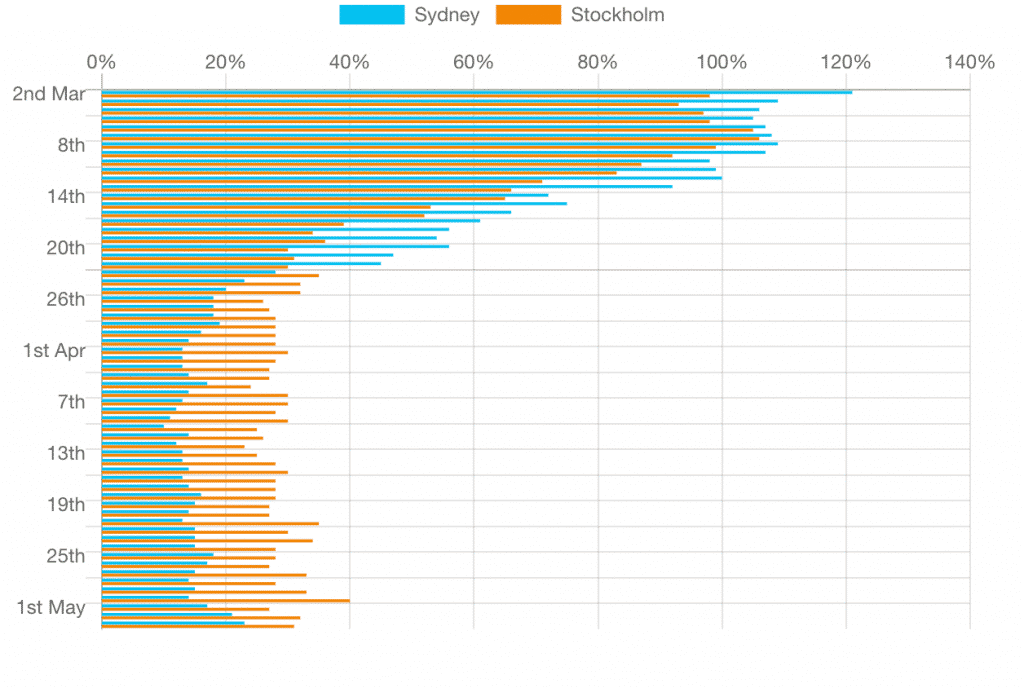There can be no doubt in the mind of a rational non-patisan thinker that the best thing to do as the covid-19 pandemic swept the globe was to keep our options open by controlling the virus. The alternative, as pursued by Sweden (for example) is to lose control for very little gain.
According to city mapper, Stockholm has seen about 30% of its normal activity in recent weeks. In comparison, Sydney has had about 15% (though in the last few days this has crept up to 23%, as restrictions ease).

So while we are now catching up on Sweden, in terms of activity, for around 5 to 6 weeks, we have had about 30% to 50% less activity than Stockholm, in our largest city, Sydney. But when it comes to deaths arising from the pandemic, we are better off.
As you can see below, as of May 4, Sweden has 265 deaths per million people, and Australia has less than 4 deaths per million people. We have controlled the virus to a large degree. They have not.
Now, since we have such a low death rate, we can make decisions from a position of having multiple options (unlike Sweden).
To hear some people talk, you would think that the 261 deaths per million people that we have thus far avoided are irrelevant. Their reason for arguing is this is often that many of those deceased were old or ill. But if you value the lives of old or ill people, then clearly Sweden has already paid a huge cost for its laissez-faire attitude. And it’s not clear they’ve gained much beyond a little more economic activity for less than two months.
Those arguing for policies that would see us emulate Sweden should be explicit about the number of extra people they are willing to see perish for their freedoms.
They will not do that. Instead they will argue that it is somehow possible to let this incredibly contagious virus to be contained to the healthy members of our populace. That seems unlikely, since it has not been achieved anywhere, but perhaps it is possible. But it would take weeks if not months to implement the necessary bubbles around vulnerable people. That would require careful planning.
But this does not mean we can persist indefinitely in a state of lockdown. The challenge now is to release ourselves from social distancing while still managing to control the outbreak, as has occurred (to differing extents) in places like Taiwan, South Korea and Singapore.
What we must not do is let the virus rip. If we do that, our country will be beset by fear, division, and death. And most importantly, once a country lets the cat out of the bag, it is very difficult to put back in.
What we should do is start a discussion about our priorities when it comes to re-opening our communitities.
In NSW, we have already allowed visits by two adults (plus dependent children). This allows grandparents to see grandchildren, and best friends to share a laugh over a beer. We won’t be re-starting our economy right away, but we will ease back into it.
At some point, we’ll butt against the limits of what we can manage without instituting widespread masks, testing and tracing. So we’ll need to make decisions.
Are we willing to all wear masks when we go to a cinema, if it means we can have cinemas re-open?
Are we willing to pay for gym attendants (replete with masks) to disinfect every bit of equipment after every use?
Are we willing to move our school weeks to three days in the classroom, two days at home, if it means that we can more sustainably run schools?
And are we willing to ensure every student has access to Zoom and digital learning platforms from home?
Will we subsidise telecommunications for every school age student?
Can we make testing free, on demand, at any pharmacy in the country, if it means we can re-open bars and restaurants for good?
For that matter, can we compel bars and restaurants to institute temperature testing?
All these questions are key to regaining our freedoms, but none of them should be answered while the virus rips through society uncontrolled.
Step 1 is always control the virus.